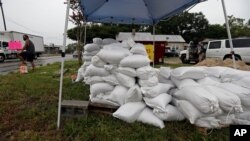Hurricane Isaias is moving northward across coastal North Carolina.
The National Hurricane Center said, since Isaias moved inland, the winds have decreased, but strong gusts are occurring over coastal North Carolina and the Outer Banks knocking out power to thousands of homes and businesses.
Isaias initially made landfall near Ocean Isle Beach, with maximum sustained winds of 140 km/h (85 mph) just after 11pm EDT on Monday.
Forecasters said South Carolina and North Carolina and other states in the region can expect rainfall amounts of 7 to 15 centimeters (3 to 6 inches).
Heavy rainfall along the East Coast, near the path of Isaias, will result in flash flooding, some of which may be significant in North Carolina through the Mid-Atlantic and Northeast today and tonight.
Potentially life-threatening urban flooding is possible in Washington, D.C., Baltimore, and areas along the densely populated Interstate 95 corridor through mid-day Tuesday.
Tropical storm warnings are in effect from the Virginia border north to the state of Maine, in the upper northeast.
President Donald Trump declared a state of emergency in North Carolina to free up funds for federal officials to help towns and cities coordinate disaster relief efforts.
Trump made a similar declaration Saturday for Florida, which was spared the full impact of the storm.







